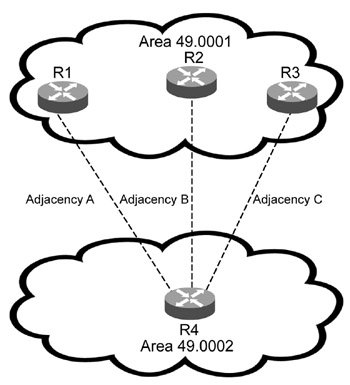L2 Router Problem
L2 routers perform routing based on the area address in the IS-IS packet and route packets toward the area ID without considering the internal structure of the area. An L2 router is always connected to another L2 router or L1-L2 router in a different area. An L2 router can have neighbors in other areas and has a Level 2 link-state database with all routing information about inter-area routing.
L2 routers form adjacency relationships with only L2 or L1-L2 routers. If an L2 router is forced to form adjacency relationship with an L1 router, it is considered a misconfiguration. Consider the example shown in Figure 10.4.

Figure 10.4: An IS-IS network depicting an L2 router problem.
In Figure 10.4, there are two areas with Area 49.0001 and Area 49.0002. There are four routers—R1, R2, R3, and R4—in the IS-IS network. R1 is an L1 router, R2 and R4 are L2 routers, and R3 is an L1-L2 router. Three possibilities of adjacency establishment are shown in the figure: Adjacency A between R1 and R4, Adjacency B between R2 and R4, and Adjacency C between R3 and R4. The problem is Adjacency A is illegal, whereas Adjacencies B and C are correct configurations. To troubleshoot the routers in IS-IS networks:
-
Use the show clns neighbor command to check the adjacency relationships of routers. The output of show clns neighbor command at R4 is as shown in Listing 10.28.
Listing 10.28 Output of show clns neighbor Command at R4

R4#show clns neighbor System Id Interface SNPA State Holdtime Type Protocol R1 E1 0000.0b47.c957 Up 14 L1 ISIS R2 E2 0000.0c34.c324 Up 10 L2 ISIS R3 E3 0000.0c45.b445 Up 9 L1L2 ISIS

In Listing 10.28, Adjacency A established between R1 and R4 is incorrect.
-
Form the correct adjacency relationship with an L2 router or L1-L2 router. The correct configurations are Adjacency B or Adjacency C.
-
Verify the newly formed adjacency on R4 by using the show clns neighbor command. The output of show clns neighbor at R4 is shown in Listing 10.29.
Listing 10.29 Output of show clns neighbor Command at R4
R4#show clns neighbor System Id Interface SNPA State Holdtime Type Protocol R2 E2 0000.0c34.c324 Up 0 L2 ISIS R3 E3 0000.0c45.b445 Up 9 L1L2 ISIS
| Note | The show clns neighbor command on any L2 router should give the Type column as either type L2 or L1-L2 but not L1. |
EAN: 2147483647
Pages: 130